Catalogue 2025
Below, browse the 2025 Rencontres Internationales catalogue, or search the archives of the works presented since 2004. New video clips are routinely posted and the images and text are regularly updated.
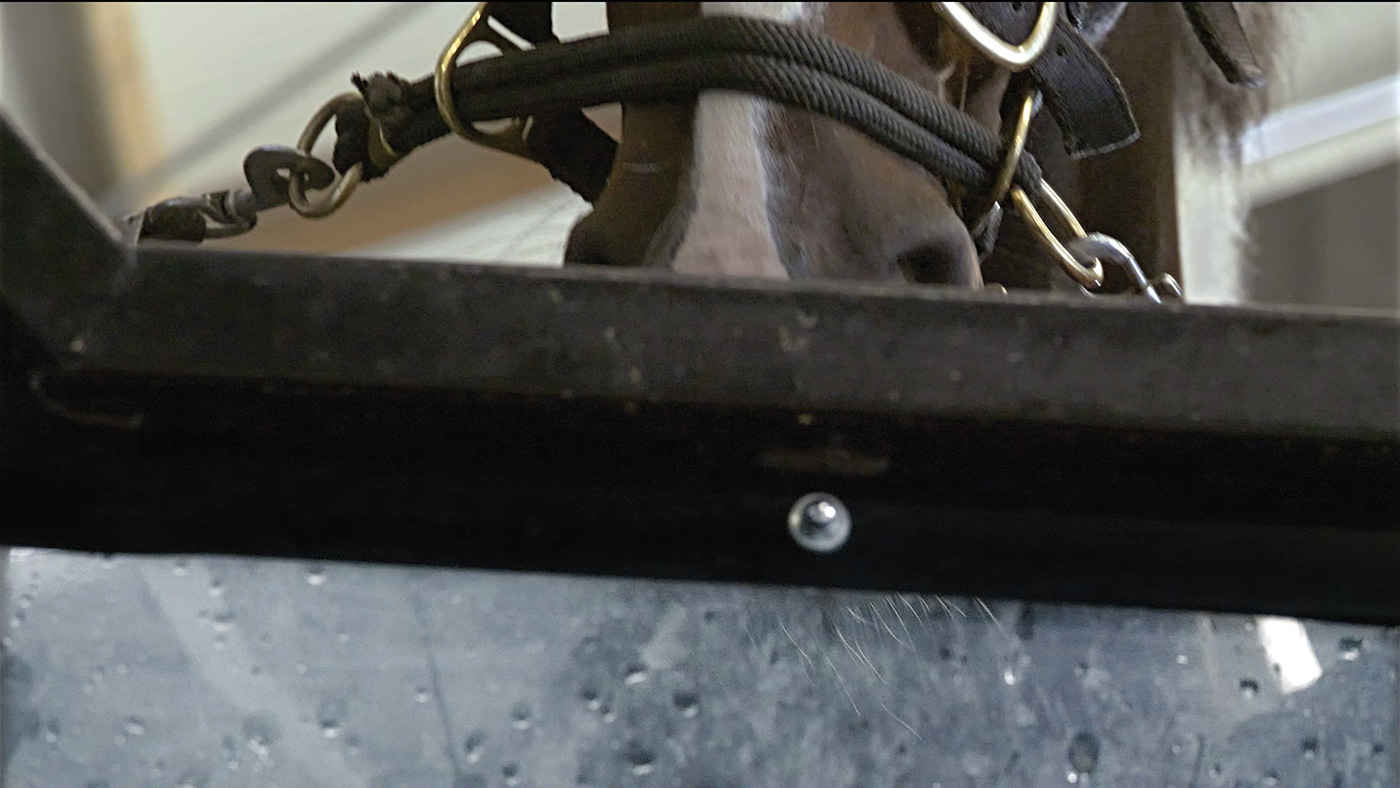

Bea De Visser
The Sonic Gaze
Multimedia installation | 0 | color | 6:10 | Netherlands | 2025
A horse is placed in an enclosed space on an aqua trainer treadmill, doubly enclosed by only the sound of splashing water. We hear much more than we see due to the recorded frequencies and the ambient range of the horse's hearing. Through pitch compression, specialized recording equipment and sound recordings far from the set, the horse's auditory experience has been made audible to humans. Its result is an acoustic representation of the animal's subjective perspective. Through the horse's sonic filter, we hear a different world, yet equally real, than the one we see on screen. While we watch with our human gaze, we hear the horse's complex sonic reality.
Bea de Visser is known for her film art, installation work and sound performances. Her work can best be described as a digital media-based practice -from the perspective of a painter and storyteller who sees the world through different lenses. AnimaIs are a recurring motif in her work. Her latest works focus on non-anthropocentric storytelling. She mixes fiction with the everyday and emphasizes structures of power, dominance and control. Her work seduces the viewer through a rich audiovisual language, exploratory in its narrative. Bea de Visser comes from a background of painting and a study electro acoustic sound. She initially began her career as a sound and performance artist in the trendy club scene and artist’s spaces, early 1980-ies. Bea de Visser attended the Rijksakademie van Beeldende Kunsten in Amsterdam (1993-1995).
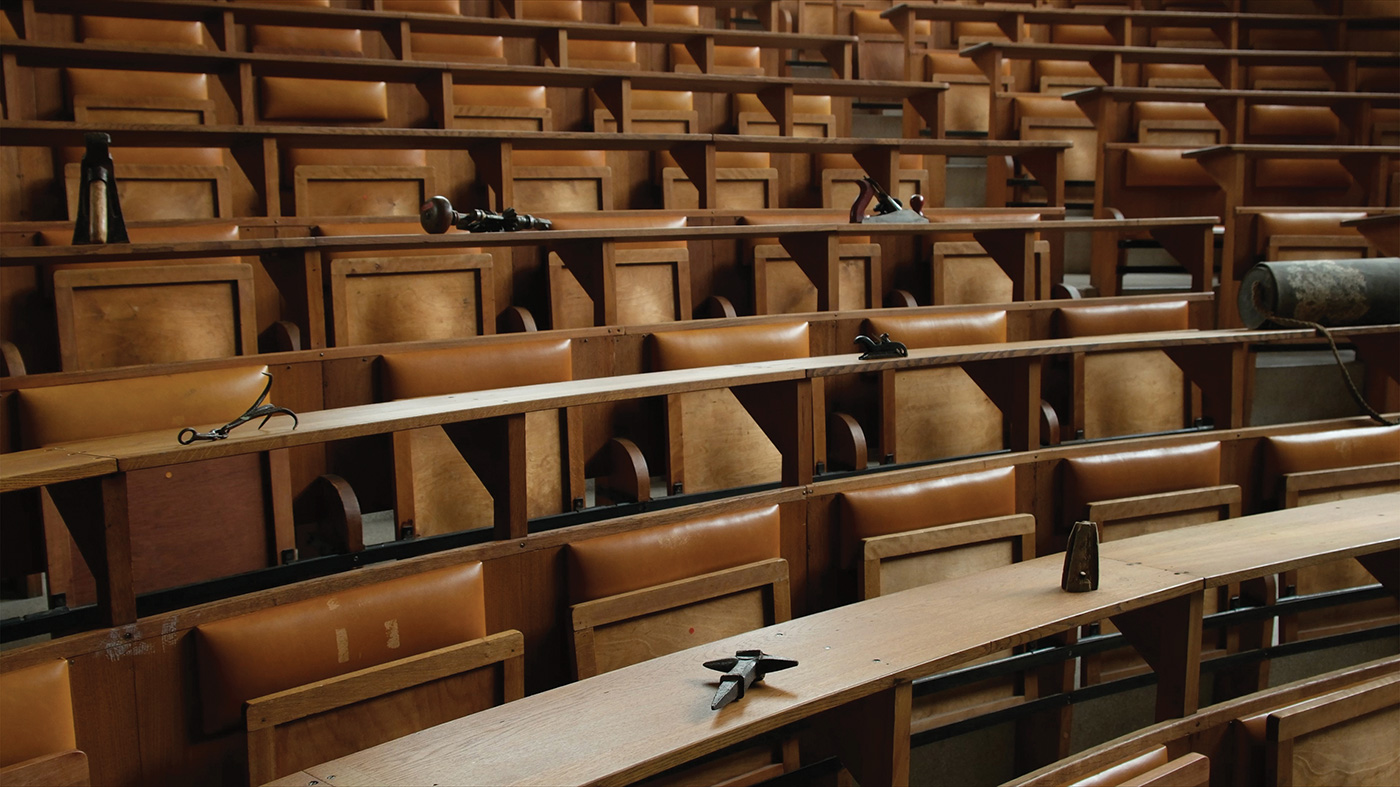
Arthur Debert
La Conférence des Instruments Savants
Experimental video | 4k | color | 9:1 | France | 2024
In a wooden amphitheatre built in 1933 for the study of animals and plants, a group of ancient tools attend a lecture. The talk seems to be about animals and their movements, but the tools gradually come to understand that it’s about the living beings that have given them their names and sometimes even their shapes.
Born in Paris in 1990, Arthur Debert lives and works between Nancy and Berlin. Arthur Debert’s protean practice is rooted in collective work and exchange. Anchored in a contextual approach, his work takes shape through travel, encounters and multiple collaborations. Central to these exchanges is the question of the transmission and survival of knowledge. Objects encountered in the field are seen as both witnesses and bearers of epistemological narratives to be deciphered. To reveal the different cultural layers sedimented within them, the artist disrupts their temporal linearity through shifting spatial settings and collective activations. Installations, videos and editions then fix the ephemeral, indeterminate state of the resulting lived experiences. Arthur Debert is a graduate of the École de l’Image in Épinal (2011), the École Supérieure d’Art de Lorraine in Metz (2013) and participated in the École Offshore in Shanghai (2014-2015), a research program of the École Nationale Supérieure d’Art et de Design in Nancy. His work has been shown at Centre Dürrenmatt Neuchâtel (2025), Triennale de la Jeune Création (Luxembourg, 2013 and 2021), Koraï (Cyprus, 2023), Ann Arbor Film Festival (Michigan, 2022), Berlin Art Prize (2018) and Berlin Independent Film Festival (2023).
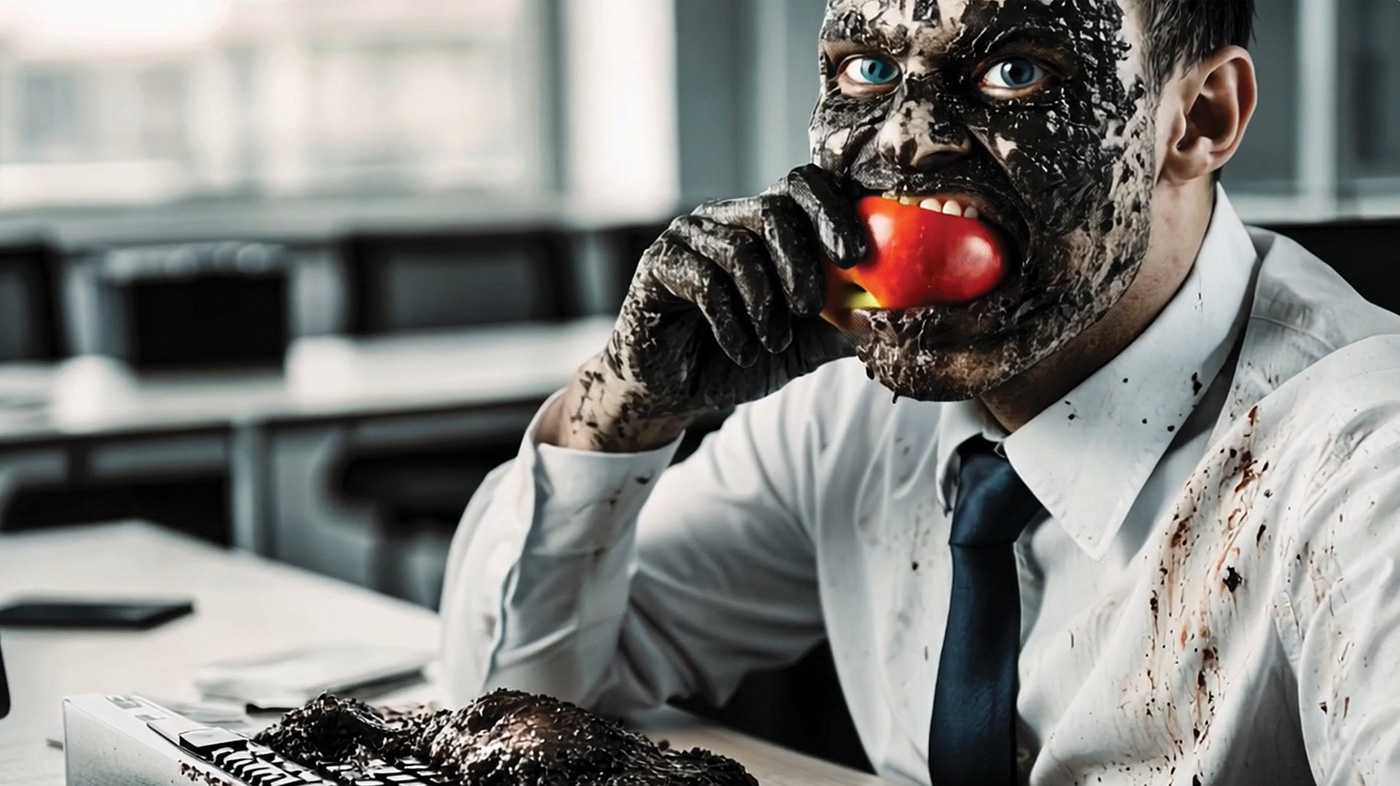
Stéphane Degoutin, Gwenola Wagon
Apple
Experimental film | mov | color | 4:0 | France | 2025
Everything is Real shows the reddest apples, the greenest call centers, the server rooms with the most cables, the smiliest employees, the delivery drivers with their most beautiful parcels, the most efficient volunteers, the biggest mountains of waste - but pushes them to the extreme of stereotyping: insensitively, stereotypes go to extremes.
Stéphane Degoutin is an artist and researcher. His work explores “dark systems,” the structures that often go unnoticed yet organize our lives: from air conditioning to international airports, from music for houseplants to urban infrastructures. He undertakes a form of reverse engineering of these hidden logics, in order to imagine other ways of thinking and acting. Gwenola Wagon is an artist and researcher. She is a University Professor and teaches at the Sorbonne School of Arts at Paris 1 University. Through installations, films, performances and books, she imagines alternative and paradoxical narratives for thinking about the contemporary digital world.
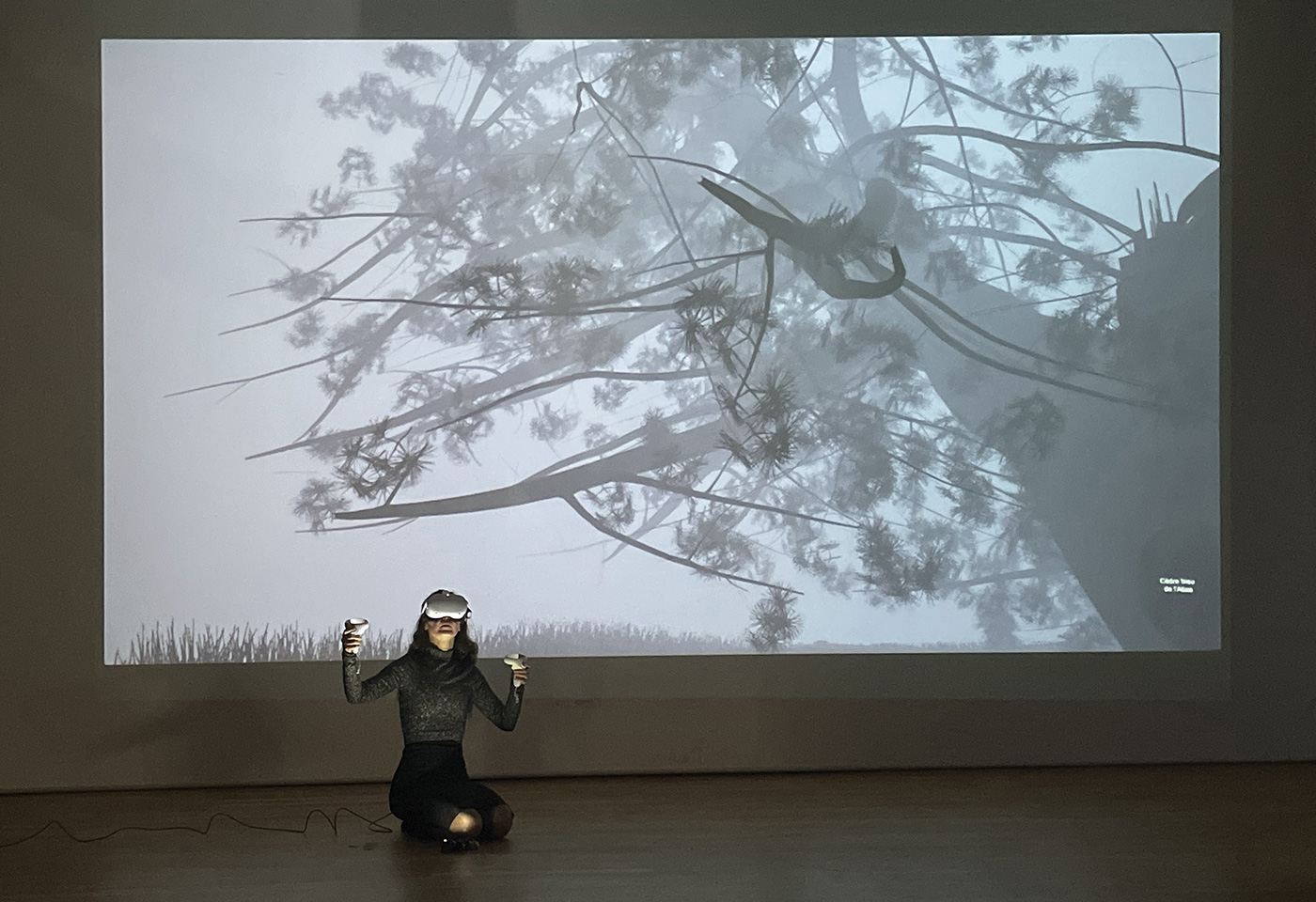
Sandrine Deumier
Le Jardin d'acclimatation
Experimental VR | 0 | color | 0:0 | France | 2023
At first glance presenting itself as a mysterious botanical garden shrouded in mist and dotted with interactive panels and tactile objects, Le Jardin d’acclimatation is an anthropised space, shaped by human perception and systems of thought. As the viewer explores this virtual environment — freely accessible yet offering only limited visibility — it gradually branches into adjacent spaces, opening onto other modes of visualisation. These successive stages reveal the enigmatic complexity of plant organisms in interaction with their environments. Each layer of perception functions as a threshold to be crossed, highlighting in particular the often-invisible complexity of root systems and mycorrhizal processes, as well as the diverse modes of nutrition, communication and interaction (associations, symbioses, mutual aid, and not least predation strategies). Available through three distinct yet complementary modes (exploratory, intuitive–emotional, and scientific), the journey through this botanical garden unfolds into multiple parallel scenes, expanding our perceptual capacities and allowing for a deeper understanding of the plant world. Original music: Sonia Paço-Rocchia A work produced at the public agricultural institution Chartres–La Saussaye as part of a partnership between the DRAAF, the DRAC, and the Centre–Val de Loire Region (France).
Sandrine Deumier is a multidisciplinary artist working across performance, poetry and video art. Her practice explores post-futurist themes through the development of aesthetic forms shaped by digital imaginaries. Driven by an interest in digital storytelling and immersive artistic experiences, she has spent several years developing poetic and visual fictions centred on speculative visions of the living world. Ecological concerns and imagined futures lie at the heart of her research. Her work focuses primarily on how new technologies might allow us to imagine alternative ways of inhabiting the world from an animist perspective — one in which the preservation of natural balances takes precedence over predation, accumulation and limitless growth.
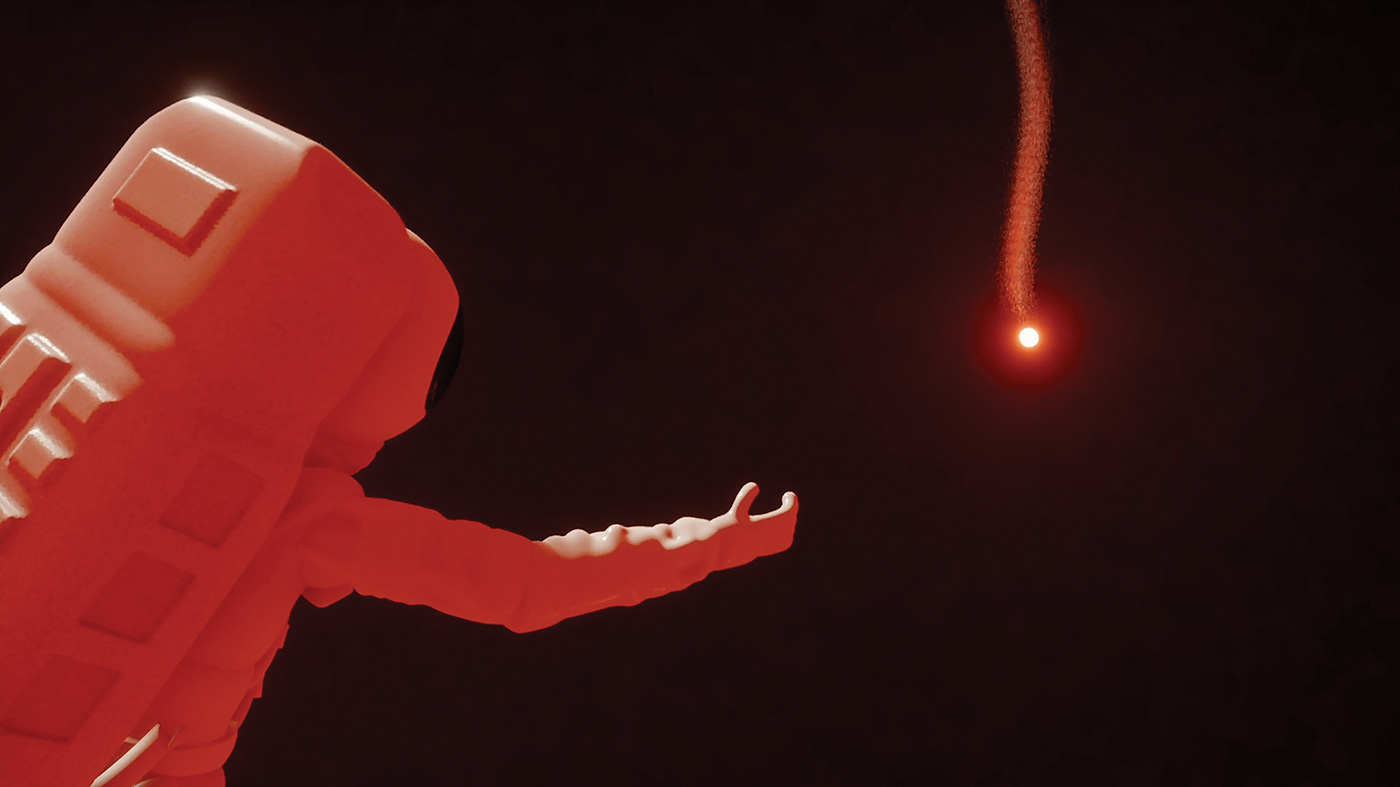
Ra Di Martino
Kant Can't Chorus
Experimental VR | 4k | color | 16:0 | Italy | 2025
The video Kant Can't (2024) centres on the oneiric portrait of a group of characters who inhabit an imaginary landscape. Astronauts fleeing from an immense figure of a woman in the process of trying to trample them, hands that emerge like enormous archaeological ruins and gigantic insects that burst onto the scene, form the scenario of an escape into the absurd. The relationship with consciousness becomes an experiential journey, in which reality is magnified by our means of perception. In the video, the primary protagonist is an astronaut who has managed to escape his fate, yet then finds himself in various situations, in a succession of scenarios not unlike those of a video game.
Rä di Martino (Rome, 1975) studied in London, where she earned an MFA from the Slade School of Art. With the Premio New York, she received a scholarship to Columbia University. Her work has been exhibited internationally in museums and film festivals, including: MoMA-PS1 and Artists Space, New York; Tate Modern, London; MCA, Chicago; Palazzo Grassi, Venice; Museion, Bolzano; Magasin, Grenoble; the Busan Biennale; Manifesta 7; Kino der Kunst, Munich; Transmediale, Berlin. At the 2014 Venice Film Festival, she presented the medium-length documentary The Show MAS Go On, winning the Gillo Pontecorvo Award, the SIAE Award, and a Nastro d'Argento; the 2018 Festival presented her feature film Controfigura. In 2019, she opened the exhibition Afterall at Mattatoio - Palaexpo in Rome and at Kunst Halle Sankt Gallen. In 2022, she held a retrospective exhibition at Forte Belvedere in Florence and a solo exhibition at Torre Matta in Otranto with an installation on Carmelo Bene's archive. She opened her solo show Electric Whispers at BAC, Beirut Art Center and Fotografia Europea, Reggio Emilia in 2025.
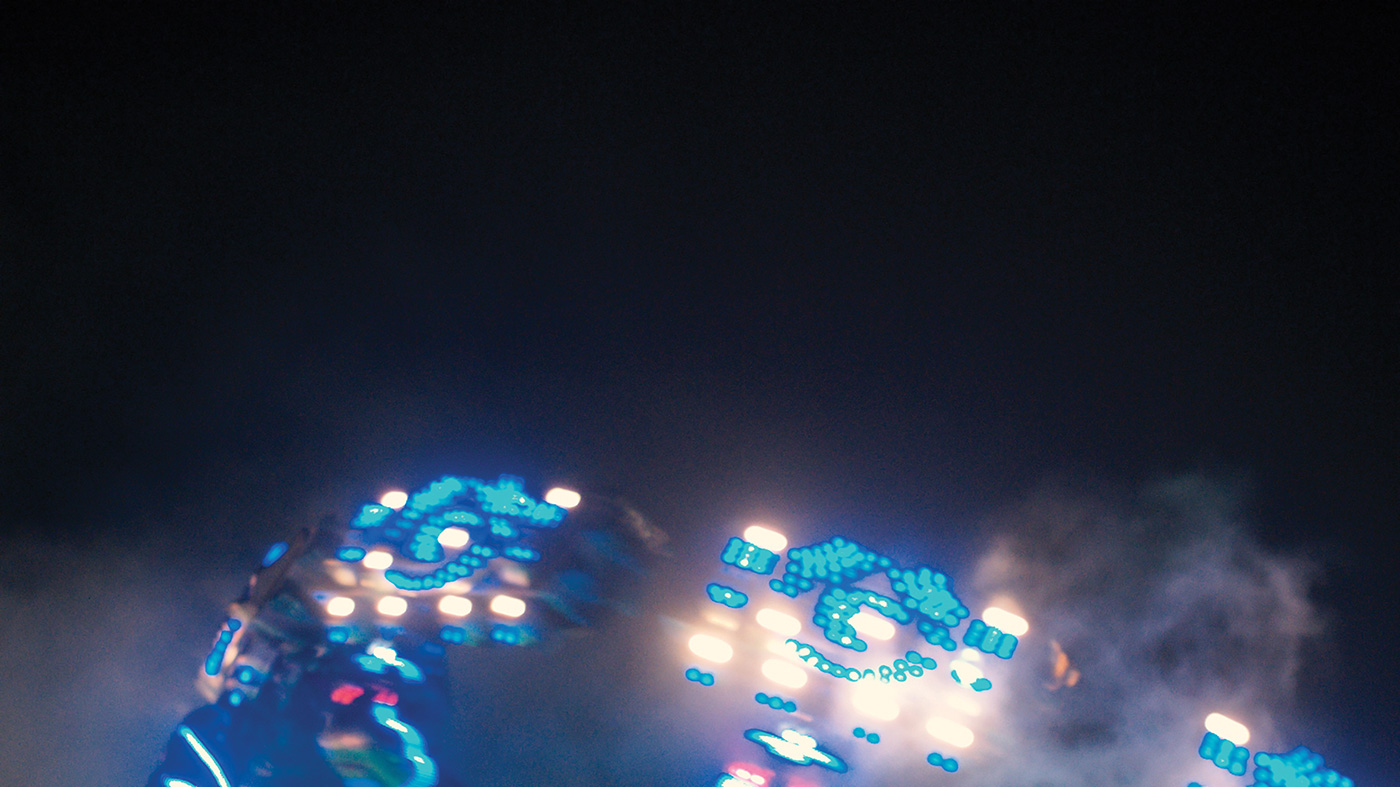

Michael Dietrich
zone of silence (scream machine)
Experimental film | hdv | color | 9:30 | Austria | 2025
The experimental film Zone of Silence (Scream Machine) explores the interplay between light, fog, and resonance to depict inner isolation and psychological disorientation. The city is enveloped in a dense atmosphere, while reflections of light and muffled sounds create a “zone of silence” in which orientation and communication begin to dissolve. Inspired by historical maritime navigation problems—where foghorns became inaudible under certain weather conditions—the film translates this phenomenon into the realm of the human unconscious. Theodor Reik’s psychoanalytic concept of the “zone of silence” serves as a central motif for repressed emotions and the difficulty of breaking through them. The closing sequence shows the fading inscription “EUROPA,” a bleak reflection on the continent’s political future. Through its dense atmosphere, a composition blending field recordings and synthesized sound, and the use of visual metaphors, the film offers a profound exploration of inner emptiness and the search for orientation.
Michael Dietrich (*1985, Vienna, Austria)studied social design at the HfbK Hamburg and Photography at the Academy of Fine Arts Vienna. His work explores the impact of human intervention on nature, often unfolding unsettling scenarios through video and acousmatic.
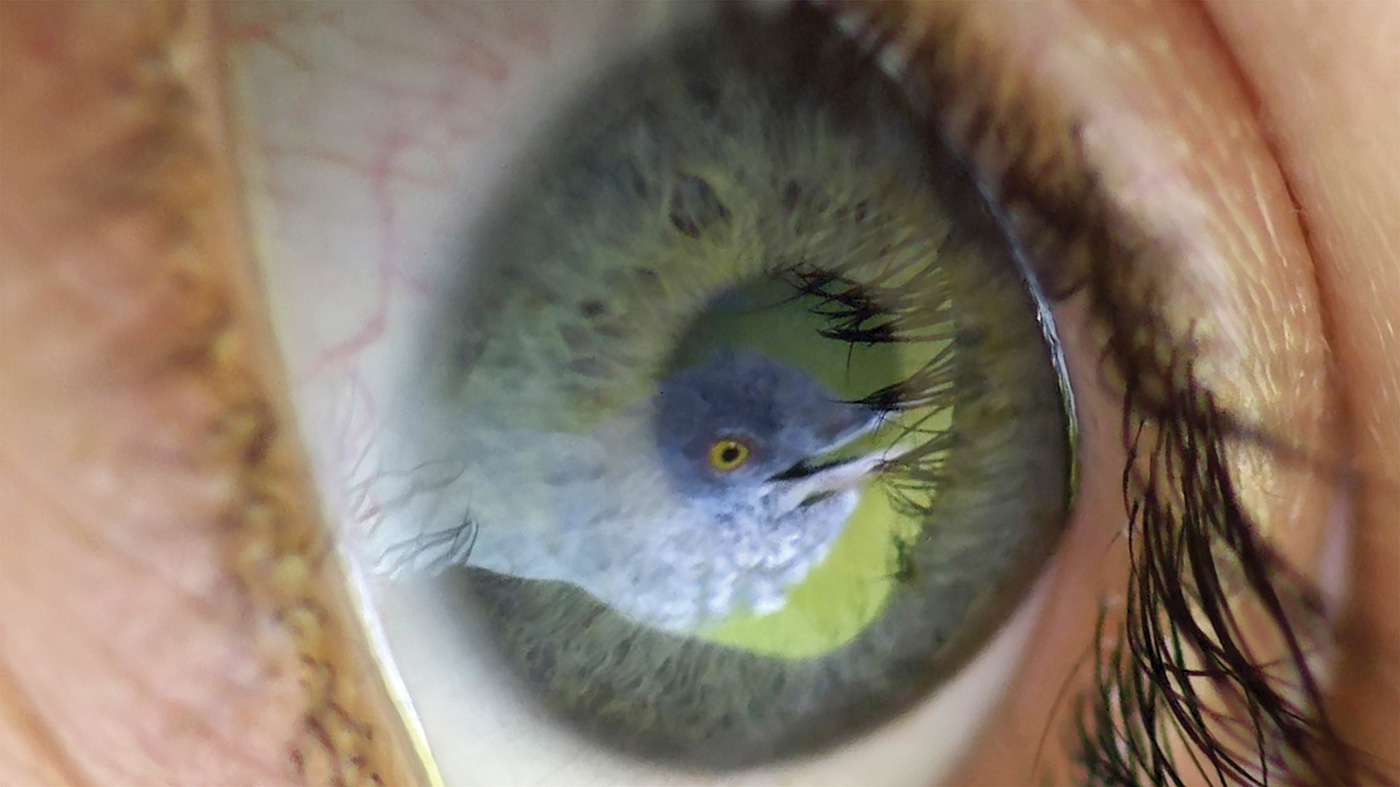
Sebastián Díaz Morales
One Glass Eye Melting
Experimental video | mov | color | 13:0 | Argentina, Netherlands | 0
One Glass Eye Melting conjures the common imaginary of dystopia to rearticulate it in search of new possibilities. A close-up of a rotating eye gazes back at the viewer, its pupil reflecting a montage of disasters—war, natural catastrophe, and mundane accidents—juxtaposed with scenes of regeneration: microbial life, cosmic expansion, and technological evolution. Filmed in a raw, single-shot sequence with minimal post-production, the eye becomes both a mirror and a fractured “memory container,” destabilised by glitches, scratches, and analogue/digital noise. The work interrogates the act of looking itself, transforming reality into something surreal yet unnervingly familiar. As the eye spins 360 degrees, the pupi’s reflection remains fixed, anchoring chaos and renewal as cyclical, interdependent forces. One Glass Eye Melting reframes disaster as inseparable from rebirth, arguing that collapse harbours the potential to reimagine—and rebuild—our narratives. Rather than revisiting catastrophe, the work asks: What do we do with these images of disaster? The work summons the collective imagination of dystopia, rearticulating its imagery in pursuit of uncharted possibilities. Part of the series Bajo el cielo cayendo (Under the Falling Sky), which explores the tension between systemic disaster and fragile hope.
Sebastián Díaz Morales was born in Comodoro Rivadavia, Argentina, in 1975 and lives and works in Amsterdam. He attended the Universidad del Cine de Antín in Argentina from 1993-1999, the Rijksakademie van Beeldende Kunsten in Amsterdam from 2000-2001, and Le Fresnoy Studio des Arts Contemporains in Roubaix, France from 2003-2004. Díaz Morales’s examination of perception and reality is based on the assumption that reality itself is by nature highly fictional. Thus, his films do not simply transport the viewer into another, surreal, or phantasmal realm, but they strip reality of its familiarity and distort it, making it seem like something else. With Diaz Morales, the viewer’s imagination does not function as a basic counterpart to the real. Rather, it operates as a force capable of evoking space and producing it diegetically, one that, beyond generating a direct visual impression, fills in the gaps in seeing and, as the film unfolds, gradually reveals to the viewer the constructedness of what we call reality. Reality is presented here as a phantasm, as something that always eludes its defining in images. It is therefore always “a little bit ahead” of the image and the viewer’s gaze. His work has been exhibited widely at venues—such as the Tate Modern, London; Centre Pompidou; Stedelijk Museum and De Appel, Amsterdam; Le Fresnoy, Roubaix; CAC, Vilnius; Art in General, New York City; Ludwig Museum, Budapest; Biennale Sao Pablo; Biennale of Sydney; Miro Foundation, Barcelona; MUDAM, Luxemburg; Calouste Gulbenkian Foundation, Lisbon; the Biennale di Venezia and Documenta Fifteen.
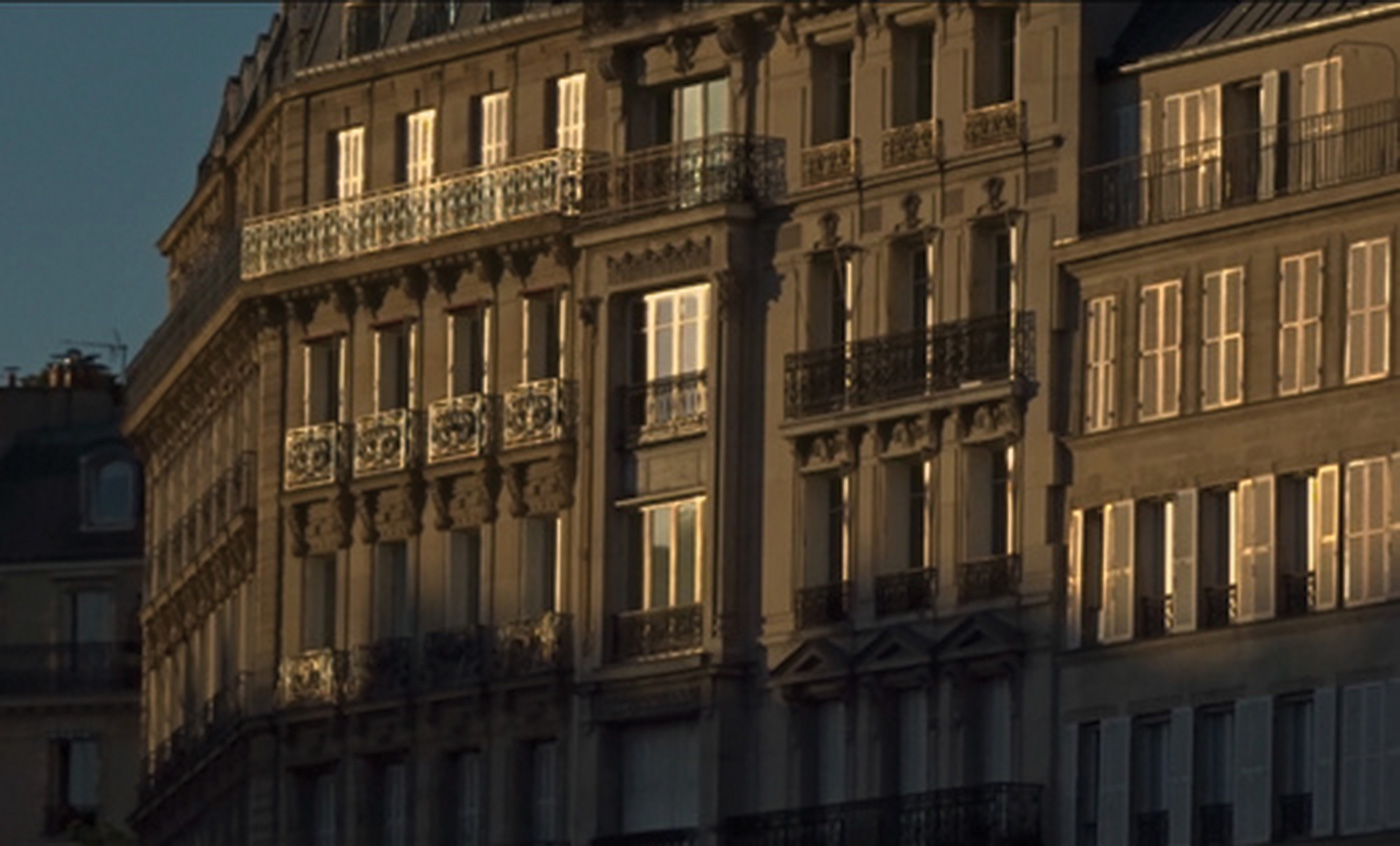
Yana Dombrowsky-m’baye
saint louis saint louis
Experimental film | mp4 | color | 26:45 | New Zealand, France | 2024
In the 21st century, you returned to the archipelagos Saint Louis of Sénégal, and Saint Louis of Paris to unearth vestiges of signares—women once at the centre of Occidental French West African commerce and society. Through the night, through the whispers of your aunts and nieces, through the institutions that house present-day French “patrimoine (cultural heritage),” you fell into a spiral between colonial presents and the past.
Yana Nafysa Dombrowsky-M’Baye is a pluridisciplinary researcher and educator from T?maki Makaurau, Aotearoa. Her matrilineal ancestry traces to Senegal and France, while her patrilineal lineage is of Polish and Czech descent. Through iterative and ritualistic processes, Yana’s practice is a poetic inquiry into the material and immaterial conditions of belonging, approaching artistic practice as archaeological gesture, unearthing the spectral, often erased presence of intercultural identities embedded in sites marked by colonial history and personal heritage. At present, Yana is at the Cité Internationale des Arts Paris, participating as one of ten internationally selected artists in the In Situ program, which will conclude March 2026.

Sam Drake
Suspicions About the Hidden Realities of Air
Experimental doc. | 16mm | color and b&w | 9:9 | USA | 2025
Fragmented records of events almost too sinister to believe: Cold War era covert radiation testing performed by the United States government on its citizens. The film grapples with the challenges of documenting the invisible, and capturing what is merely waves and frequencies. Shot on expired film, it is through the contaminated image and a complex soundscape that the unseen becomes manifest. – Cristina Kolozsváry-Kiss, IFFR During the Cold War, the U.S. government developed a program of covert human radiation experiments, using its own citizens as test subjects. Suspicions About the Hidden Realities of Air is an elliptical exploration of this dark historical episode, operating across vast landscapes and individual human bodies. Fragments of archival and 16mm imagery – shot on expired film stock – evoke the locations of numerous test sites across the United States. Urban landscapes at night, bleached scenes of the American desert, and close-up details of rural America are interwoven with voice-over and on-screen text that reference testimony of the continuing impact of this period of covert testing. – Open City Documentary Festival
Sam Drake (b. Dayton, OH) is a filmmaker based in Milwaukee, WI. Her work has been exhibited at film festivals and venues including The Museum of Modern Art, International Film Festival Rotterdam, Media City Film Festival, CROSSROADS, The Museum of the Moving Image, Alternative Film/Video, Collectif Jeune Cinéma, Non-Syntax Experimental Image, Winnipeg Underground Film Festival, Transient Visions Festival of the Moving Image, and Antimatter. She has programmed for the Union Cinema and Mini Microcinema and is currently a lecturer at the University of Wisconsin-Milwaukee.
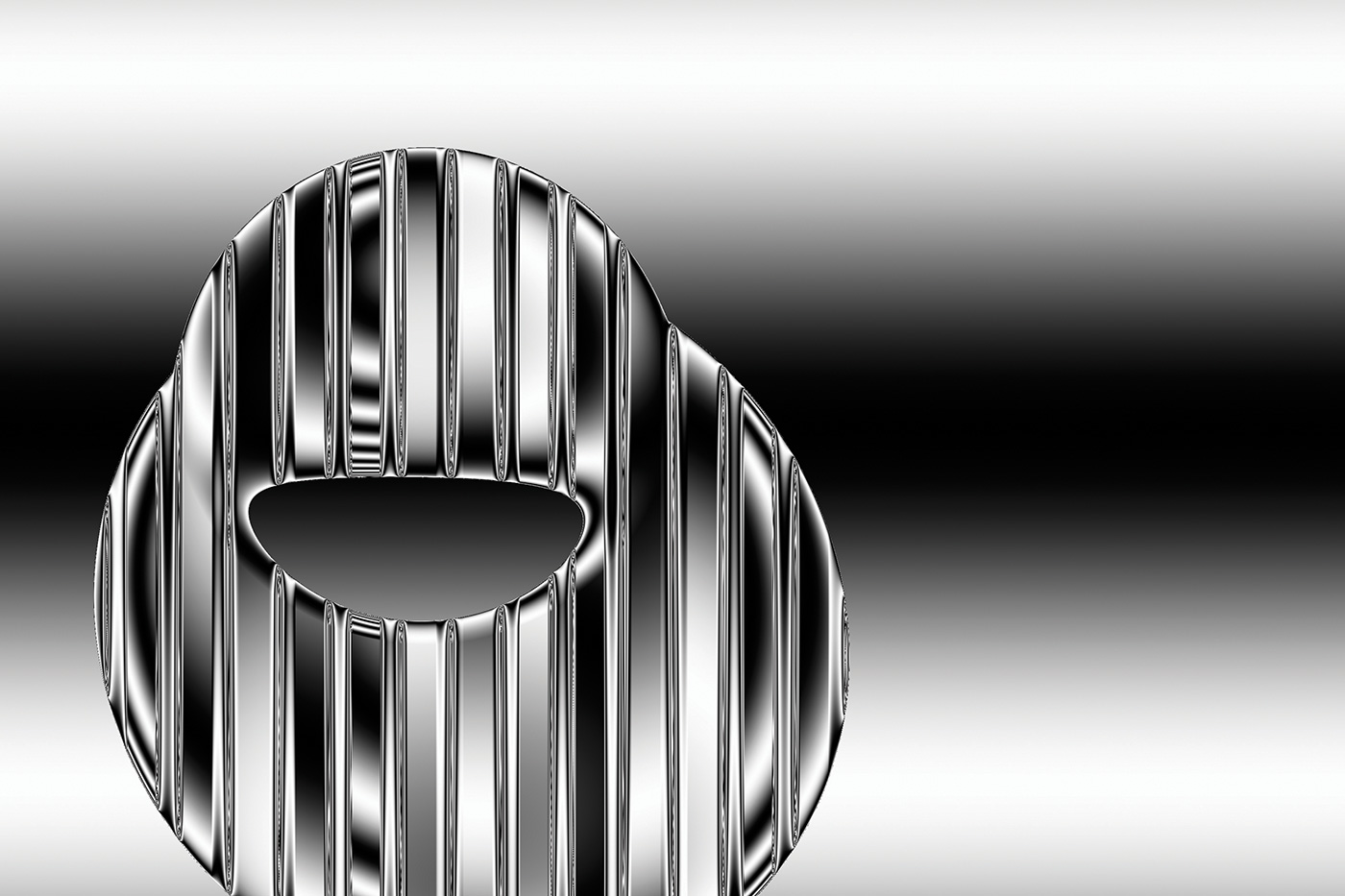
Driessens & Verstappen
E-volved Formulae
0 | 0 | black and white | 10:1 | Netherlands | 2024
The image generating Formulae E-volver software is developed by the artists. The building blocks of the software are all kinds of basic mathematical operators. The computer can compose an infinite amount of valid formulas out of these elements. Each time, a small set of formulas is composed and visualised on the screen. The viewer compares these animated images with each other and reviews them. In turn, the software responds on those reviews when it composes new formulas. Formulas that were displayed on the screen for a long time have more chance to crossbreed, whereby visual properties are mixed and passed on to future generations. The process begins with a "primordial soup" which yields relatively simple images. On the basis of personal preferences of the user, this gradually evolves into complex intriguing animations. The final results, the E-volved Formulae, are stored and are displayed on a large screen or projected. They show a wide variety of outcomes of the successive evolutionary processes.
The Amsterdam based artist couple Erwin Driessens (1963 Wessem) and Maria Verstappen (1964 Someren) have worked together since 1990. After their study at the Maastricht Academy of Fine Arts and the Rijksakademie Amsterdam, they jointly developed a multifaceted oeuvre of software, machines and objects. Their research focuses on the possibilities that physical, biological and computer algorithms can offer for image generating processes. An important source of inspiration are the self-organizing processes in nature. In the Morphoteques series (form collections), they show the form variations, which can be expressed within a specific generative process. In other works, the shape transformations are evoked in real time by means of a machine. In their software and AI projects, they develop an artificial nature, which is expressed in all kinds of variations. Driessens & Verstappen participated in numerous exhibitions in the Netherlands and abroad, a.o. Stedelijk Museum Amsterdam, Museum Boijmans van Beuningen Rotterdam, Centre Pompidou Paris, IVAM Institute Valencia, Museum Kröller-Müller Arnhem, Garage Museum Moscow, CaixaForum Barcelona, Eyebeam New York. The couple gives lectures and presentations at universities, art academies, festivals and conferences, a.o. Siggraph Los Angeles, Sonic Acts Amsterdam, Second Iteration Melbourne. In 1999 and 2001 their Tickle robot projects have been awarded first prize at VIDA Telefónica Madrid. In 2013 the couple received the Witteveen+Bos Art+technology Award for their entire oeuvre. The artists are represented by gallery DAM in Berlin.
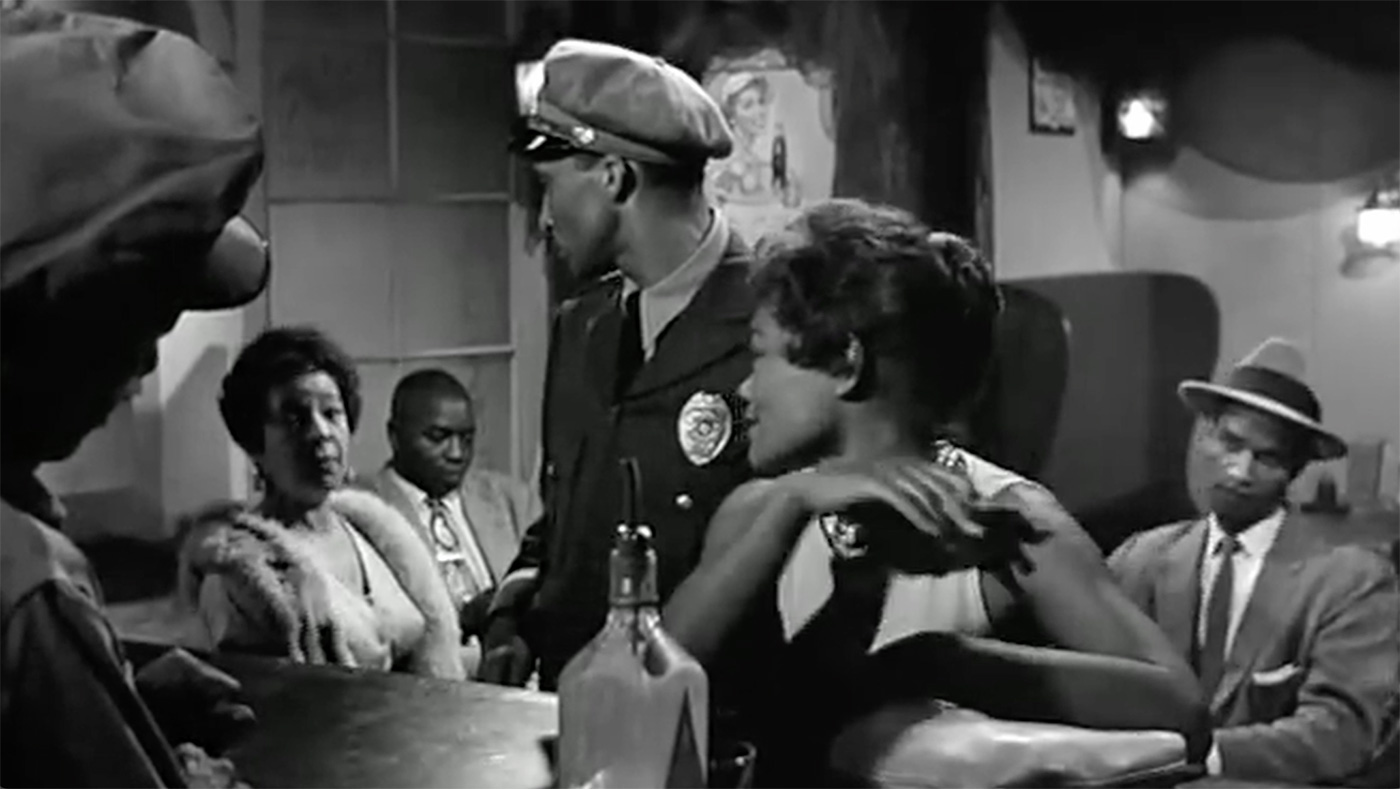
Ewa Effiom
WHEN ONE DOOR OPENS
Experimental doc. | mp4 | color | 10:44 | Belgium, United Kingdom | 2024
WHEN ONE DOOR OPENS emerges as an exploration of the intricate dynamics between authorship, representation, and history. Drawing inspiration from the groundbreaking methodologies of Arthur Jafa and the evocative aesthetics of Christian Marclay. Eschewing from the conventional confines of mainstream cinema, the filmwork delves deep into the rich tapestry of found footage, excavating and appropriating the untold narratives embedded within race films predominantly from the period immediately after the pre-Code era. In this respect it presents itself as a counterpoint to established somewhat one-dimensional work of Marclay. Through a, seemingly circuitous, narrative lens, WHEN ONE DOOR OPENS challenges conventional notions of identity and belonging, inviting viewers to confront the complexities of historical representation. Each frame serves as a portal to a bygone era, where characters navigate through the architectural spaces of both literal and metaphorical significance. The film's exploration of movement within these spaces resonates with profound symbolism, illustrating the transformative power of cinematic storytelling. Ultimately, standing as a testament to the enduring allure of cinema and the implied spaces as a medium for capturing and reimagining the complexities of human experience.
EWA EFFIOM is a London-based Belgo-Nigerian architect, writer and producer. Image Culture, Futurism and Mythology are recurring themes in his work with a focus on their association to space. He was a member of the Architecture Foundation’s New Architecture Writers’ second cohort which culminated in a critically acclaimed public programme and has been published in the Architect’s Newspaper, Dwell, the AJ, ICON, Wallpaper, Frame, OnOffice, Architecture Aujourd'hui, the Modern House magazine, A Daily Dose and Ex Libris amongst others. His piece Architecture, Buildings and Conservation in MAJA was nominated for best piece in the 2022 Estonian Architecture Awards a year after he came second place in the Tallinn Architecture Biennale’s 2021 Curatorial Competition with a proposal entitled Adaptive Re-use. His film Eagle Mansions was premiered at the 2021 Urban Film Festival in Perth and screened at 2022 Melbourne Design Week, before he was awarded the 2022 How To Residency at the Canadian Centre for Architecture entitled “How Not To Be A Developer.” 2022 was also the year that his second film “Beck Road” premiered at the Open City festival before screening at the 18th Venice Architecture Biennale. He was a 2023 LINA Fellow and awarded both the Film Lab residency at the MAXXI Museum in Rome where he made “When One Door Opens” which screened at Demanio Marritimo-278 before being shown at restless architecture exhibition curated by Diller Scofidio and Renfro at the MAXXI Museum. He also took part in the Theatrum Mundi Staging Ground Residency with his collaborative exploration of infrastructural change in Paris in the aftermath of the Olympics. He later returned to LINA to give the State of Architecture Address in 2025 which was met with critical acclaim which was a plea for the archtiecture industry to return to imagination. Though he hasn’t been a lecturer at MA in Architecture + Urbanism at the Manchester School of Architecture since 2022, he is still a visiting critic at the Estonian Institute of Technology and London Metropolitan University.
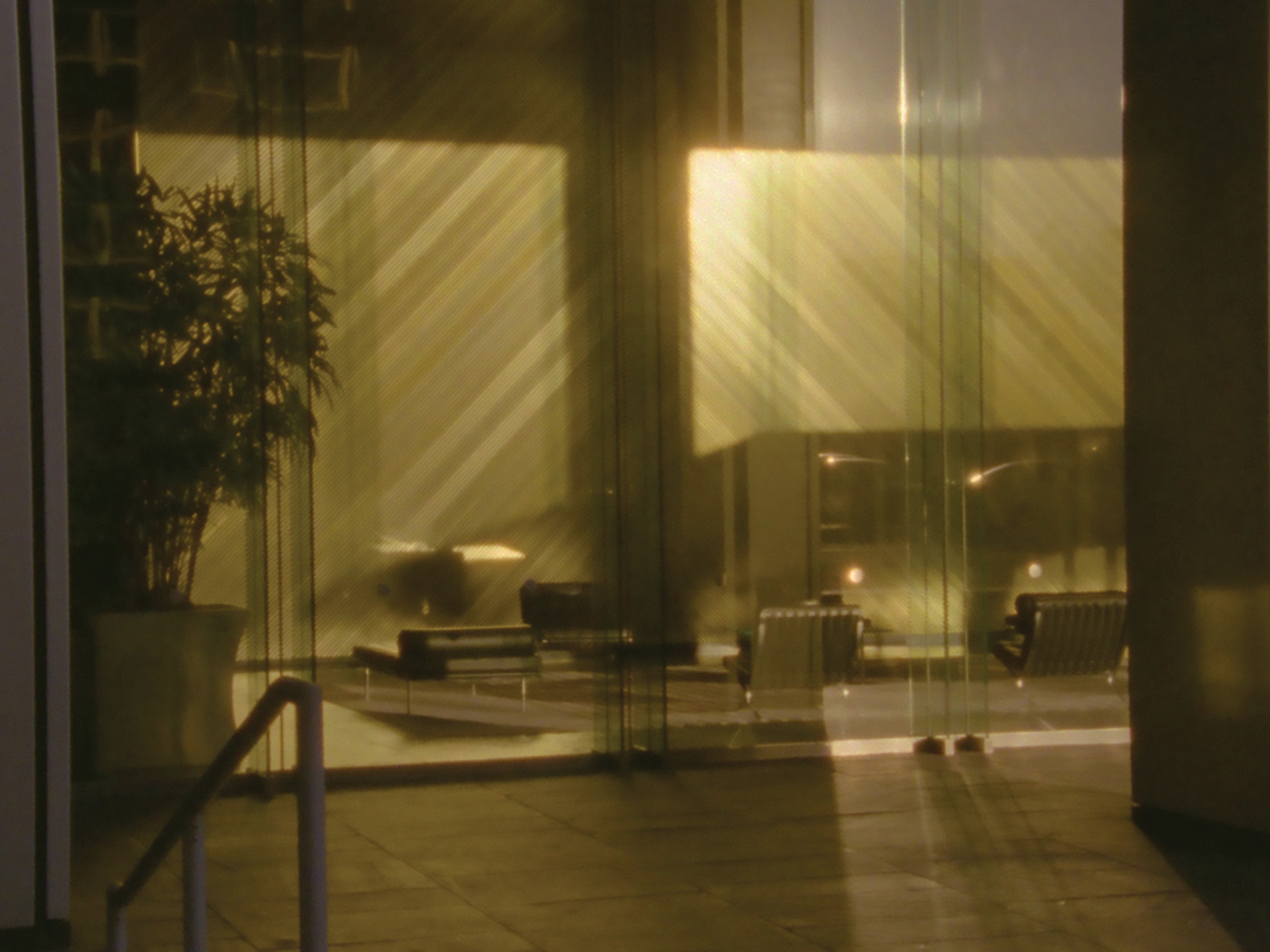
Zachary Epcar
Sinking Feeling
Experimental fiction | 16mm | color | 20:0 | USA | 2024
Three white collar commuters recall an experience of getting trapped on a train in San Francisco's transbay tunnel, each drifting into fantasies of sex, death, and other intimacies with strangers. "A beguiling, spacious, and transportive work of suspended tension, that looks for new forms of intimacy in the antiseptic. An urban office park becomes a reflecting pool for the erotic fantasies of a derailed train where we wait, shake and survive together.” - 25 FPS grand jury
Zachary Epcar (b. San Francisco) is a filmmaker whose work has screened at the international film festivals of Toronto, New York, Rotterdam, San Francisco, Vancouver, Edinburgh, and Melbourne; Berkeley Art Museum & Pacific Film Archive, Media City, IndieLisboa, European Media Art Festival, EXiS, 25 FPS; and in solo screenings at the Museum of Contemporary Art Chicago, Museum of the Moving Image, and Black Hole Cinematheque. His films have been featured online on MUBI, Le Cinéma Club, and Ecstatic Static. Zachary lives in Oakland, California where he is a member of the film programming collective Light Field. His films are distributed by Light Cone (Paris).
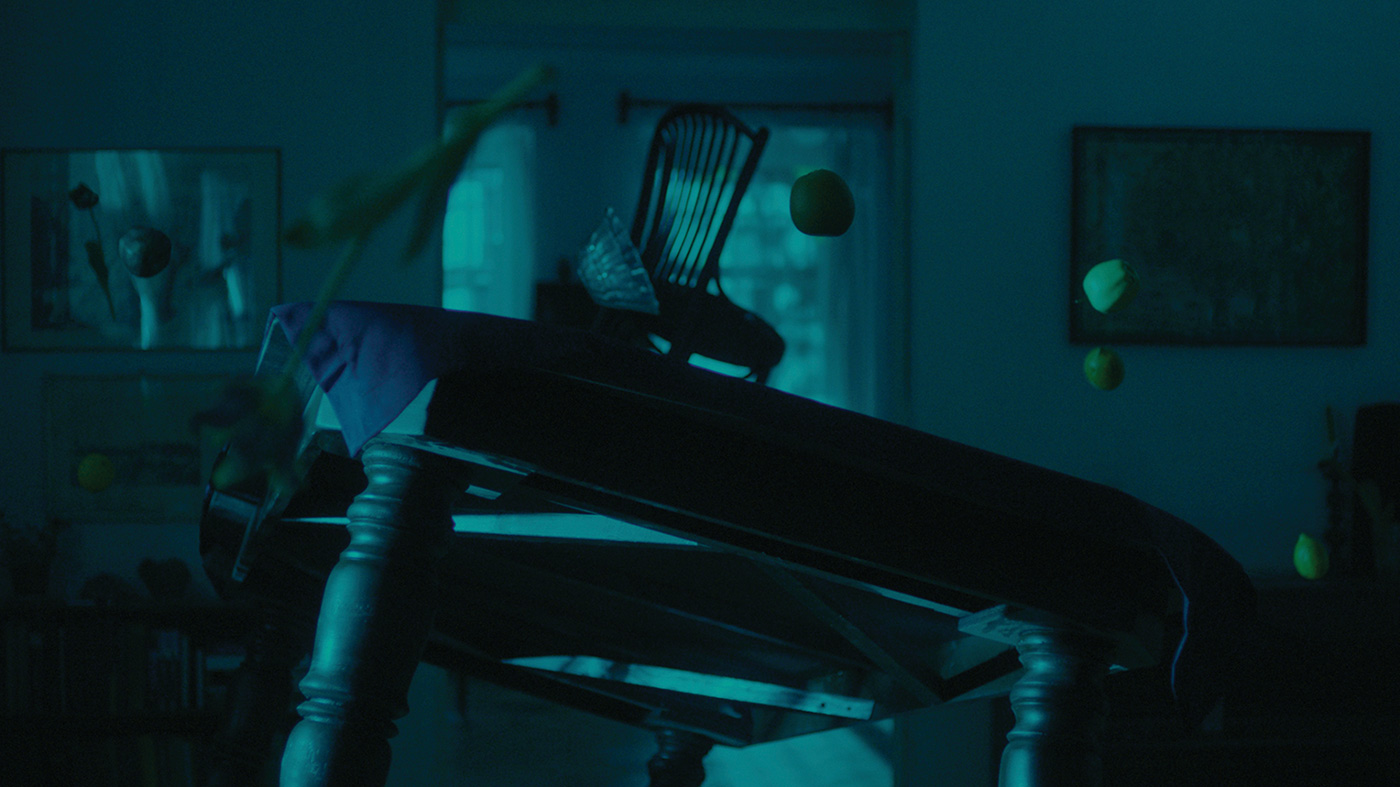
Andro Eradze
Flowering And Fading
Experimental film | 0 | color | 16:22 | Georgia | 2024
A dog and a human share sleep in the twilight of a calm house. Suddenly, the shapes of reality start to blur, and slowly, dream and fantasy take over. In his latest work, Andro Eradze shapes a new vision of surrealism, where impeccable image composition and a stunning sound work strike directly at the subconscious, submerging the senses in an ocean of absolute beauty.
Andro Eradze (b. 1993, Tbilisi, Georgia) is an artist and filmmaker whose multidisciplinary practice investigates the intersection of presence, memory, and spectrality. Through photography, installation, video, and experimental cinema, Eradze explores the agency of non-human entities within landscapes that blur the boundaries between human and non-human experiences. His projects often evoke liminal spaces, exploring the unexpected actions and relations among objects, plants, and animals. He took part in several solo and group exhibitions and screenings in international institutions including MoMA PS1, New York; The 59th Venice Biennale, Venice; The New Museum, New York; WIELS Contemporary Art Center, Brussels; GAMeC, Bergamo; 22nd Biennial Sesc_Videobrasil, Sao Paulo; 14th Kaunas Biennial, Lithuania; Fondation Vincent van Gogh Arles.
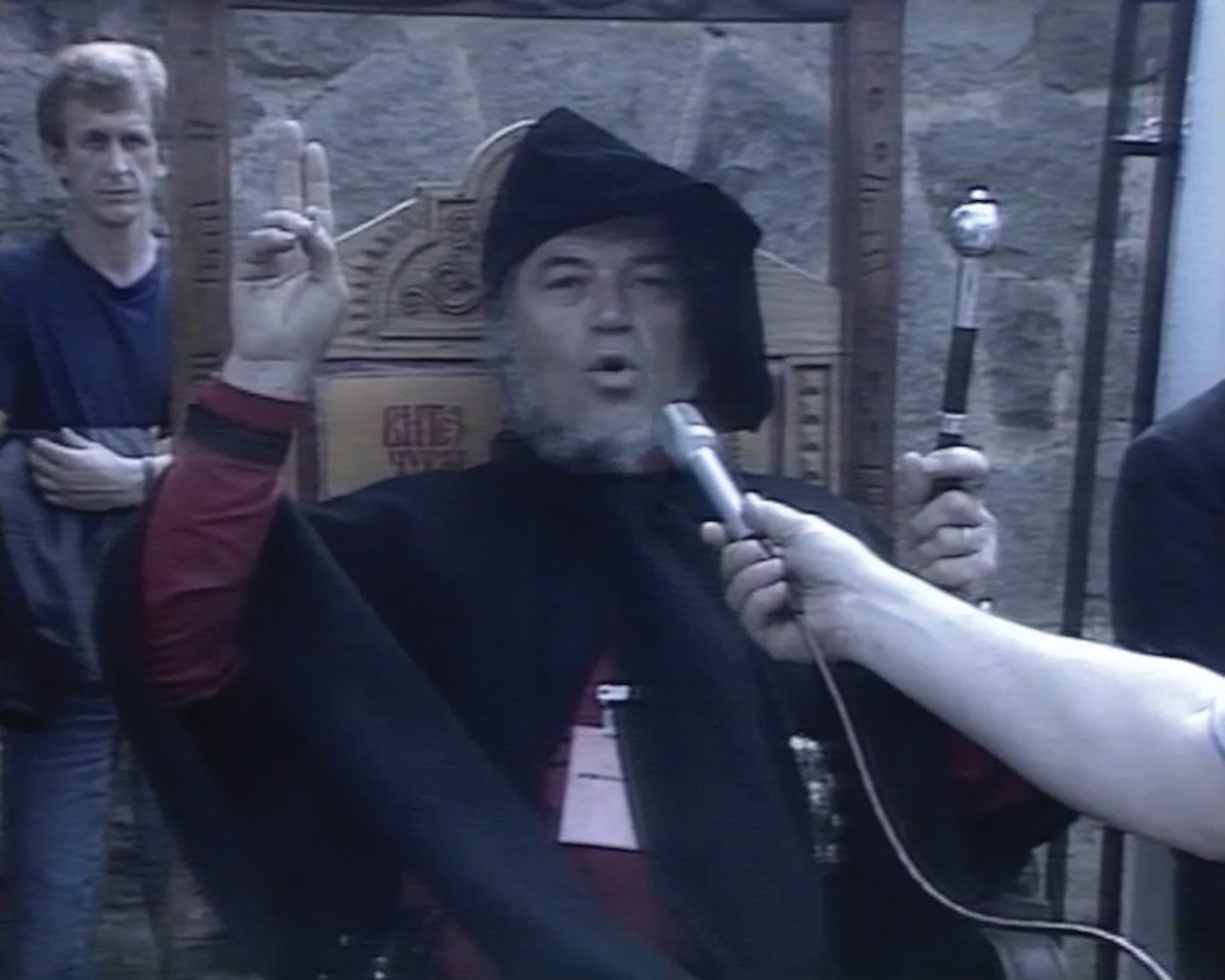
Bojan Fajfric
Greetings from Kosovo 1989
Experimental doc. | mov | color | 13:39 | Slovenia, Netherlands | 2025
Greetings from Kosovo 1989 (2025) nSingle-channel video, (DV Pal 4:3), 13:39 min. Greetings from Kosovo 1989 deals with archive footage from the 1989 gathering in Kosovo, made famous by Slobodan Miloševi?’s speech. Addressing a crowd of over a million, he spoke amid rising ethnic tensions in Kosovo and growing political unrest in Yugoslavia. His mention of “armed battles” in Serbia’s future has made this speech infamous, often seen as foreshadowing the Yugoslav Wars. Reframing and subverting the format of a TV reportage, the work emphasizes the mass hysteria, madness, and banality of nationalistic and religious iconography. In light of recent world events, revisiting this episode—an inseparable part of the history that profoundly marked the end of the 20th century—is a crucial gesture, as this history remains very much alive.
Bojan Fajfri? (Belgrade, former Yugoslavia) is an artist and filmmaker based in the Netherlands since 1995. A graduate of the Royal Academy of Fine Arts in The Hague and former resident at the Rijksakademie in Amsterdam. Working primarily with moving images and photography, he creates layered narratives that reflect on history’s impact on individual lives. His interest lies in the porous relationship between memory and the moving image. His work has been presented at institutions such as Palais de Tokyo (Paris), Baltic Centre for Contemporary Art (Gateshead), San Telmo Museum (San Sebastián), De Appel (Amsterdam), the Belgrade October Salon, NGBK (Berlin), and the Center for Cultural Decontamination (Belgrade). His films have screened widely at international festivals including the International Film Festival Rotterdam, International Short Film Festival Oberhausen, Vienna International Film Festival, DOK Leipzig, Sharjah International Film Festival, Tempo Documentary Festival (Stockholm), Rencontres Internationales Paris/Berlin/Madrid, and Impakt Festival (Utrecht).
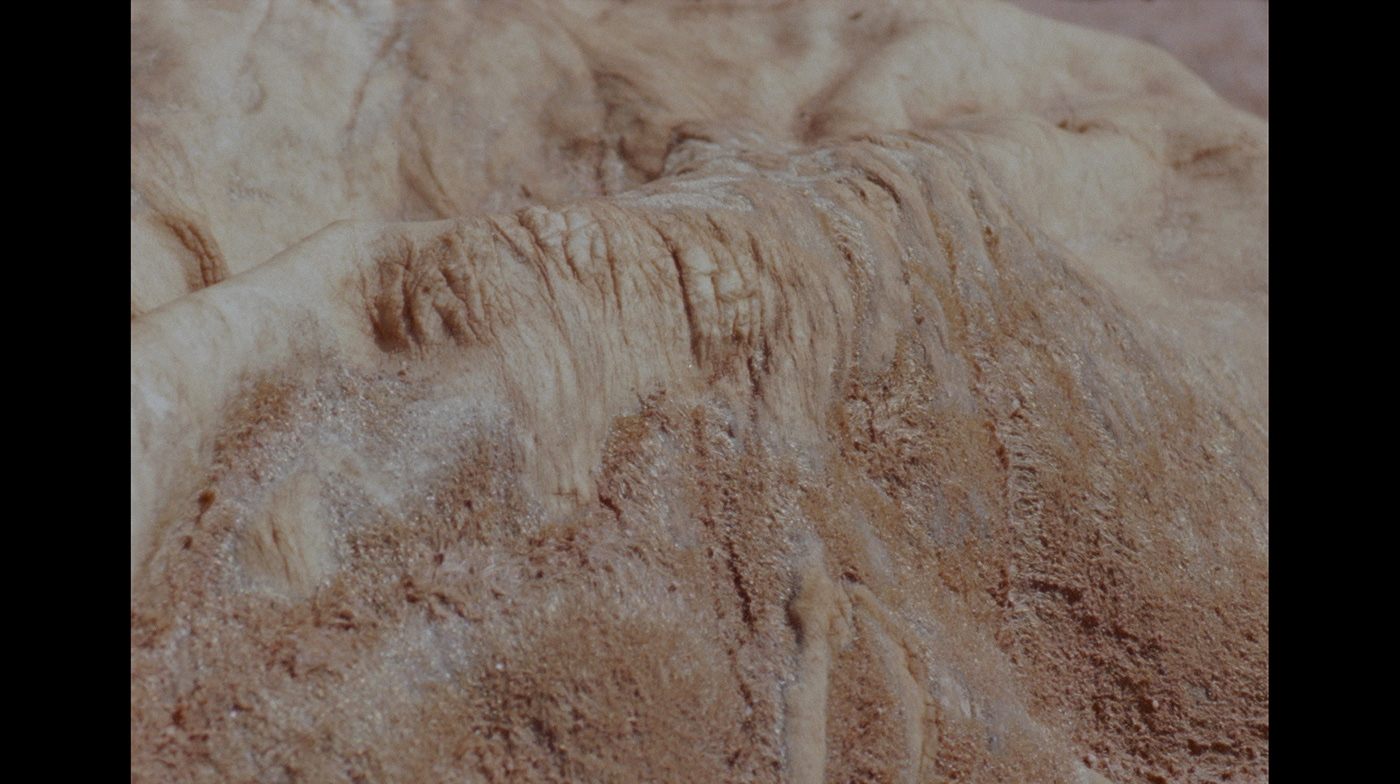
Laurence Favre
Zerzura
Experimental doc. | 16mm | color | 11:0 | Switzerland | 2024
Named after a mythical lost oasis, Zerzura addresses questions on our relations to the non human: How do we perceive 'nature'? Is it a 'thing' to which we humans are external? Or are we all part of a mesh where there is no centre nor periphery? Can an assemblage of sounds and images invite us to see 'nature' as living, sentient and endowed with agentivity? Following 'Resistance' (2017) and 'Osmosis' (2022), 'Zerzura' closes the trilogy 'Corpus Animale'.
Laurence Favre is an artist, filmmaker and researcher. Her practice revolves around analog images, sounds and writings. She makes experimental films, installations and film performances, looking for ways of triggering epistemic changes through sensory perception. Her films are shown internationally in film festivals (Locarno Film Festival, Visions du Réel, Rotterdam IFFR, Ann Arbor Film Festival and others), in art spaces as well as in informal spaces and in the frame of symposiums. She has been awarded several artist grants and residencies. Laurence is an active member of the artist-run filmlab LaborBerlin, and a co-funder of SPECTRAL, a platform for the creation and diffusion of Expanded Cinematic Arts.
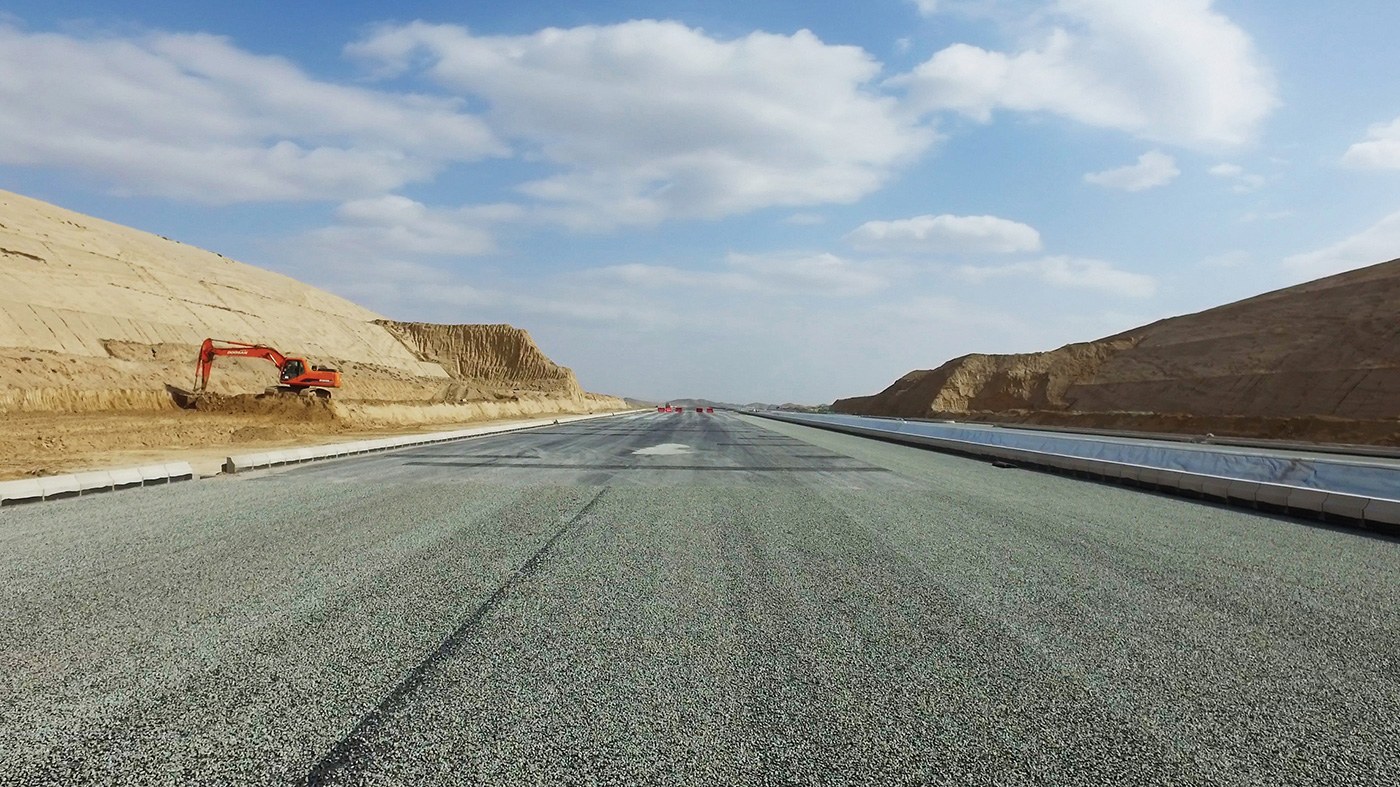
Aurèle Ferrier
Claws
Experimental doc. | 4k | color | 18:27 | Switzerland, China | 2025
CLAWS is a moving-image essay of gliding takes through rapidly expanding cities, drifting from peripheral terrains into dense cores before opening back to the horizon. In largely unpopulated frames, architecture, materials and sound turn urban expansion into a field of perception—where geometry persists, intention falters, and the land remembers.
Aurèle Ferrier is a Swiss visual artist working with film, exploring built environments and urban peripheries. CLAWS concludes his trilogy on human-made landscapes. His moving-image works have been shown at the Hiroshima City Museum of Contemporary Art (Hiroshima), IDFA (Amsterdam), Rencontres Internationales (Paris/Berlin), Open City Documentary Festival (London), Anthology Film Archives (New York) and Image Forum (Tokyo).
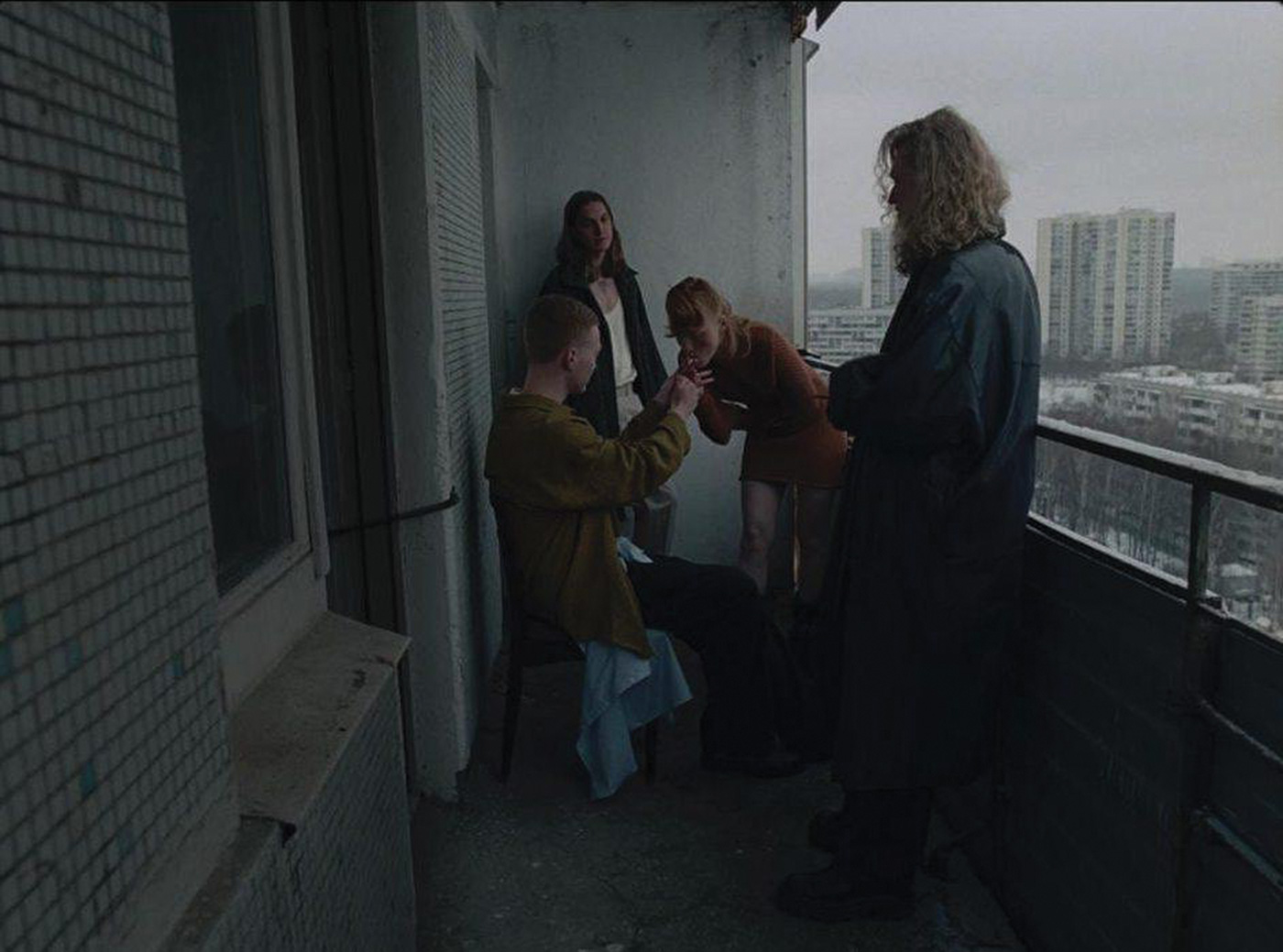
Liliia Filina
INNER IMMIGRATION
Experimental film | 35mm | color | 3:36 | Russia | 2025
In a nameless Eastern European city, few young people, finds themself trapped between silent resistance and passive complicity as their country descends into war. The city’s streets, once familiar, become a landscape of fear. Shot in stark, observational style, Inner emigration is a haunting portrait of a generation suspended in stillness, forced to navigate a crumbling reality that no longer offers clear choices.
Lily Filina is an artist and director, born in Kaluga, Russia, 1999. A graduate of the Rodchenko Art School, class of Sergei Bratkov, she works as an advertising director and develops independent projects at the intersection of cinema and video art. In 2024, Liliya's film participated in the program of the Rotterdam Film Festival. In 2024, Liliya's project "Internal Emigration” was supported by the Yandex360 program.
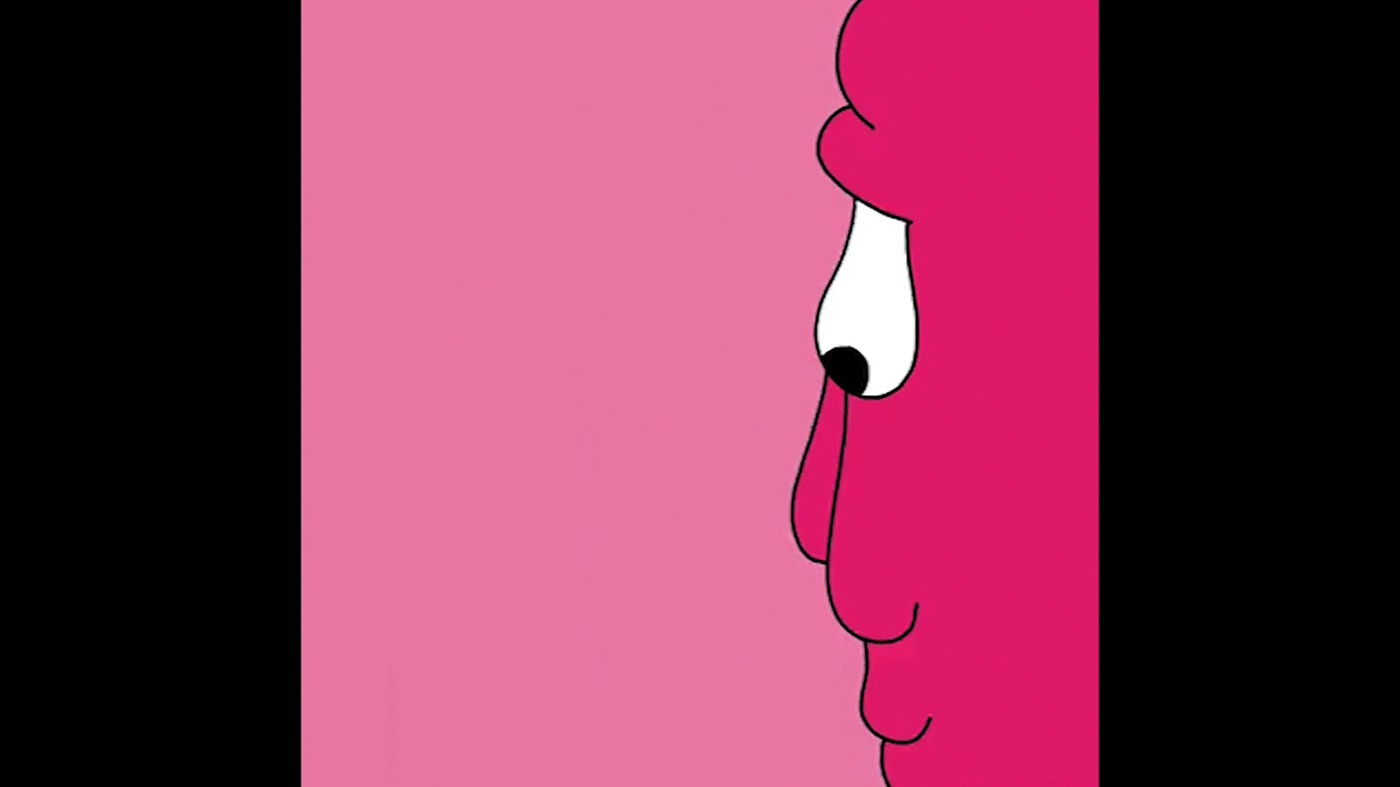
Lisa Freeman
Hook, Spill, Cry Your Eyes Out
Experimental film | mp4 | color | 2:26 | Ireland | 2024
A headfirst rush into the capitalist, urban landscape, using dynamic camerawork and canny editing. Productivity, optimisation, constant forward motion. In this experimental short from artist and filmmaker Lisa Freeman, frenetic camerawork and quickfire editing convey the body’s lacklustre requirement to always be working in our capitalist society. Using glimpses of concrete environments, bodies on treadmills, crash-test dummies, and other ubiquitous urban images, and melding these with a soundscape of ragged breathing and disjointed conversations, Hook, Spill, Cry Your Eyes Out provides a cutting commentary on what our society inflates with importance.
Lisa Freeman is an artist and filmmaker based in Dublin, Ireland. Her work draws into question economic and power structures and explores how intimacy might be employed as a form of resistance. Recent works have examined the everyday, where the city’s sounds play in the dreams, nostalgias, or hopes of another and where small moments lead to more surreal events (Slipped, Fell and Smacked my Face on the Dance Floor), and social isolation in the public realm (Hook, Spill, Cry Your Eyes Out). Freeman is a studio member at Temple Bar Gallery + Studios, Dublin. She has received several Bursary and Project awards from the Arts Council of Ireland. Her work is held in the collection of the Arts Council of Ireland. Freeman has taken part in residencies in South Korea (BARIM Arts, 2016), and Cité Internationale des Arts Paris x Institut Francais, supported by Temple Bar Gallery + Studios Dublin and Bétonsalon, Paris (2025).
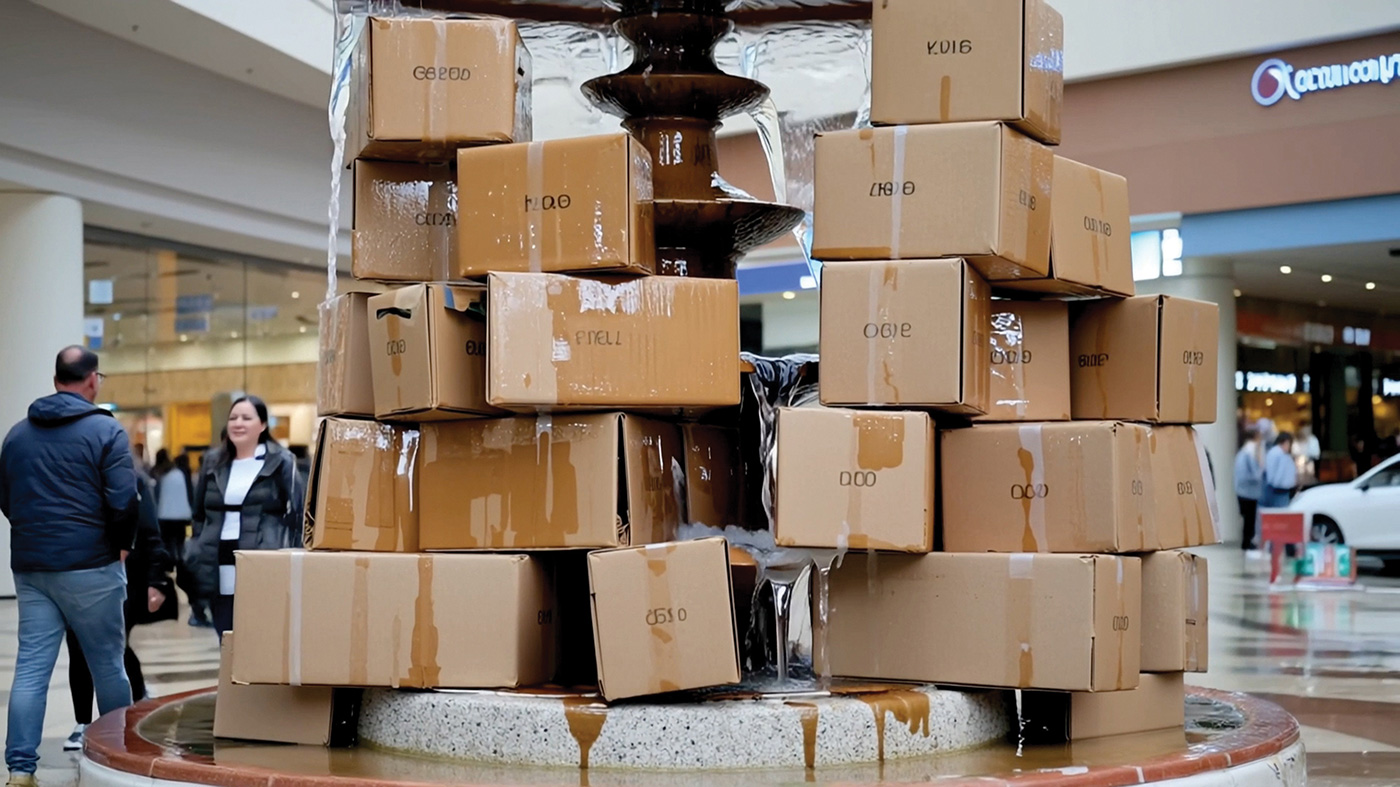
Moritz Frei
Am I the sleeping bag of my soul?
Experimental film | mp4 | color | 3:53 | Germany | 2025
Clowns at a flooded piano, eerie stockbrokers, cardboard fountains in urban spaces. Without a clear narrative structure, the boundaries between self, body and consciousness become blurred. Familiar signs appear alienated, spaces dissolve, meanings remain elusive. Despite its abstraction, the film seems strangely connected to our present. It is as if it were uncovering a deeper unease beneath the surface of everyday images, one that is difficult to name but remains palpable.
Moritz Frei is a visual artist who works with installation, video, text and sound. His practice moves between analysis and absurdity, using humour as a strategy to question social and media structures. Experimentation and possible failure are integral parts of his artistic process, allowing him to playfully explore control mechanisms and perception. Frei studied at the Academy of Visual Arts in Leipzig. For many years, he worked part-time in video stores, the Filmgalerie 451 Berlin and Alpha 60 Leipzig, both renowned centres for experimental and international cinema. This experience sharpened his eye for the materiality and power of moving images. The initial moment for his artistic and cinematic work was Moritz Frei's first cup of coffee with Bruno Ganz for his film ‘Meine erste Tasse Kaffee’ (My first Cup of Coffee).
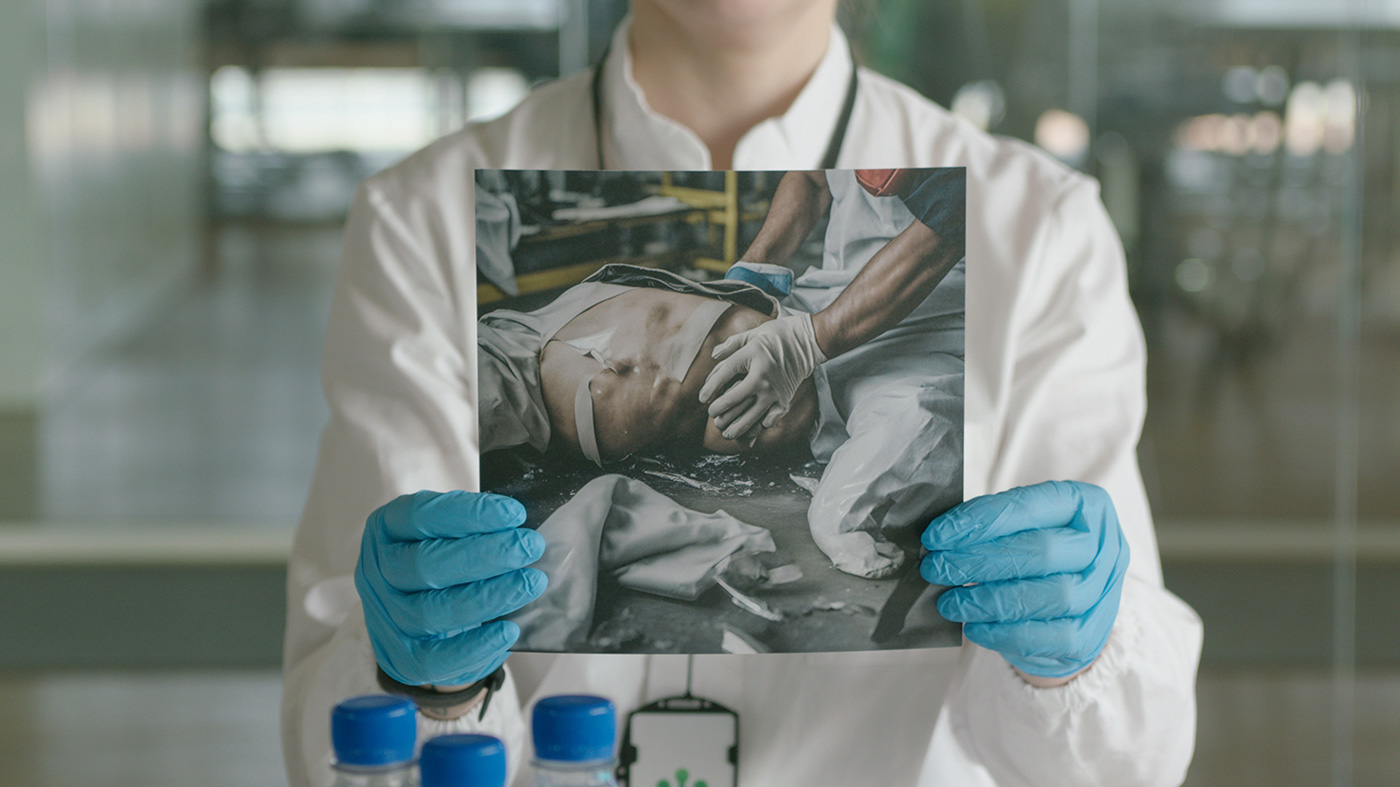

Soren Thilo Funder
Mirror Touch (Archipelago DLC_01)
Fiction | 4k | color | 19:21 | Denmark | 2024
Mirror-touch synesthesia" is a neurological phenomenon where a person feels the same touch as they see another person experiencing. Stimuli on one sense thus trigger a feeling in another. In the video work ’Mirror Touch (Archipelago DLC_01)’, employees at the high-frequency trading company Archipelago™ are subjected to a series of experimental tests in the development of synthetic empathy. The process aims to reunite the body's space with the cognitive; the corporeal with the immaterial; the real with the imaginary. Accompanied by the film's actors, the viewer is led by a commanding voice on a suggestive journey from the trading terminals to the physical reality of the factory. Here, we are reminded of the factory floor's still indisputable and violent physical reality and the worker's body as a physical witness to the violent imprint of progress.
Søren Thilo Funder is a visual artist working primarily with video and installation. His works are mash-ups of popular fictions, cultural tropes and socio-political situations, projections and histories. They are narrative constructions that insist on new meaning being formed in the thin membrane separating fictions from realities. Invested in written and unwritten histories, the paradoxes of societal engagement, temporal displacements and a need for new nonlinear narratives, Thilo Funder proposes spaces for awry temporal, political and recollective encounters.

Gerard & Kelly
E for Eileen
Fiction | 4k | color | 23:35 | USA, France | 2024
An enigmatic character spends her last day in the house she designed and built. Her solitude is interrupted by the arrival of old friends who threaten to drown her in the past. A speculative fiction, E for Eileen is shot entirely at Eileen Gray’s villa E-1027 — one of three French national monuments of the modern era, and the only one built by a woman.
Gerard & Kelly are visual artists and filmmakers whose interdisciplinary practice spans film, performance, and installation, incorporating choreography, writing, printmaking, drawing, and sculpture. Based in Paris since 2018, they are known for conceptually rigorous and research-based projects that address questions of memory and history, sexuality and the formation of subjectivity. Gerard & Kelly have collaborated since the early 2000s to develop a distinctive body of work that situates movement, narrative, and critical theory in direct conversation with architecture and site. Their projects often unfold in iconic modernist spaces and have been presented by leading institutions across Europe and the United States. Hailing from the farms of Ohio and the coal country of Pennsylvania, Brennan Gerard and Ryan Kelly met in New York and launched a collaboration that led them to the Whitney Museum Independent Study Program, where they were Van Lier Fellows from 2009-2010, and then to the University of California, Los Angeles (UCLA), where they earned their MFAs in 2013 from the Interdisciplinary Studio under the direction of artist Mary Kelly. Ruins, their first solo show in a European institution, was presented by the Carré d’Art – Musée d’art contemporain de Nîmes in 2022–2023. Solo exhibitions and performances of their work have been presented by Marian Goodman Gallery, Paris (2025), Fondation Maeght, Saint-Paul de Vence (2024), Centre Pompidou, Paris (2023), Marian Goodman Gallery, New York (2022), MAMCO, Geneva (2020), MOCA, Los Angeles (2020), Festival d’Automne, Paris (2017 and 2019), The Getty Museum, Los Angeles (2019), Pioneer Works, New York (2018), Palais de Tokyo, Paris (2016), New Museum, New York (2014), and The Kitchen, New York (2014). They participated in the 2023 NGV Triennial at the National Gallery of Victoria, Melbourne, the 2023 and 2017 Chicago Architecture Biennials, and the 2014 Made in L.A. Biennial at the Hammer Museum, Los Angeles. Their work has been included in group exhibitions at Château La Coste, Le Puy?Sainte?Réparade (2025), Collection Lambert, Avignon (2024), Le Commun, Geneva (2024), High Line, New York (2023), FRAC Franche-Comté, Besançon (2022), and Solomon R. Guggenheim, New York (2015), among others. Gerard & Kelly have received numerous awards and grants, including the VIA Art Fund (2024), Mondes nouveaux program of the French Ministry of Culture (2023), Graham Foundation (2014), and Art Matters (2013). Their works are held in the permanent collections of the Carré d’Art, Nîmes; FRAC Franche-Comté, Besançon; Solomon R. Guggenheim Museum, New York; LACMA – Los Angeles County Museum of Art; Hammer Museum, Los Angeles; National Gallery of Victoria, Melbourne; Serralves Museum of Contemporary, Porto; and Whitney Museum of American Art, New York.